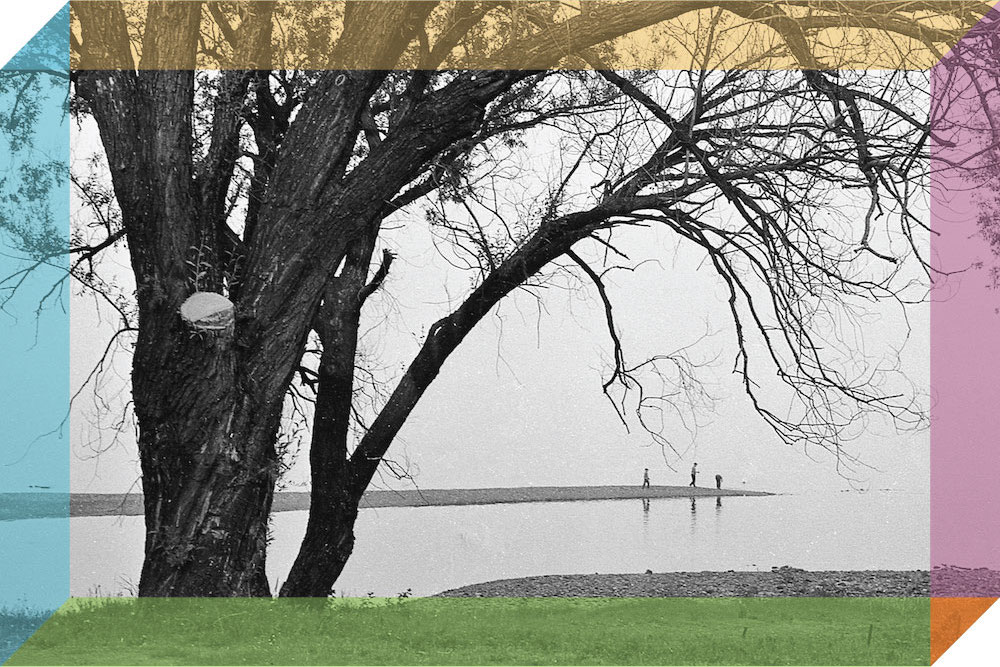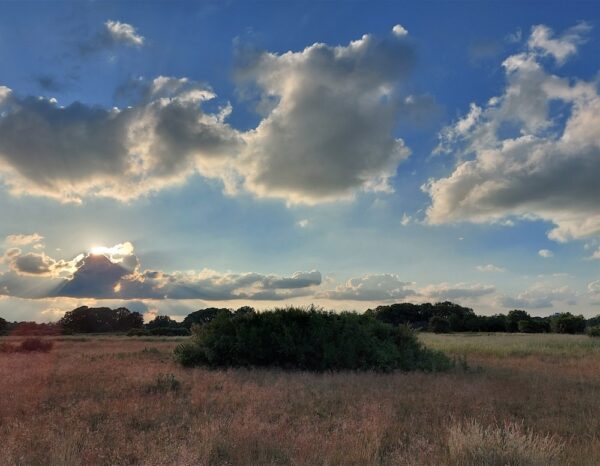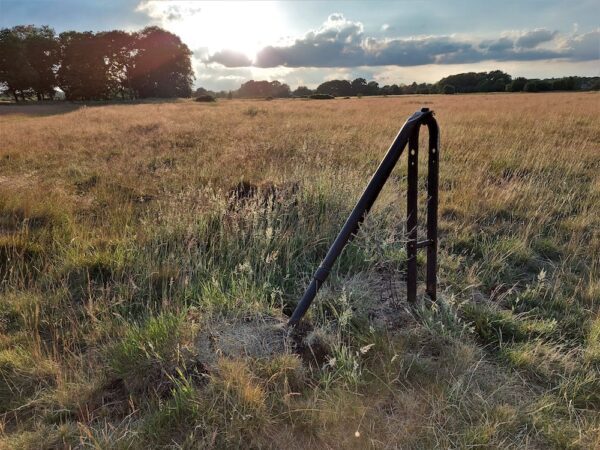
Sandbar at the mouth of the Lester River, Duluth, Minnesota, ca. 1960. Courtesy of J. Dorrance Kiser.
For me, as for millions, lockdown has been a masterclass in ways of escape. And even as “easing” widens horizons, I can’t see it catapulting us back to a time (2019) when 70 million flights filled the skies. The virologist Peter Piot put it bluntly in Science: “Let’s be clear: without a coronavirus vaccine, we will never be able to live normally again.”
So it’s unfinished, this business of escape artistry, of finding the new in a delimited world.
My partner and I live in northeast London, a mosaic of Victorian terraces and forest remnants cut through by small rivers. From Walthamstow to Wanstead, it’s been home since the 1980s—and our entire world since March. Some weeks in, I found myself scouring the London A-Z and Google Maps for green spaces nearby. They were maddeningly featureless. But maps are products of cultural consensus. They’re not the territory, and certainly not the experience of the territory. So we became terranauts of the local, seekers of the sort-of known—even a “universe next door.”
When we first moved here, it was barely signposted. We discovered its history in stages and on the ground. Wanstead Park, for instance, is a zoo of monuments including an Italianate temple and decaying grotto crouched among towering oaks and limes. I discovered that they are all relicts of a “lost Versailles,” a Palladian-style villa and formal gardens sold off and broken up in the 1820s. Further back, the Tudor Henries (VII and VIII) hunted here, and the dubious favourite of Elizabeth I, Robert Dudley, owned a hall on the site where she partied up a storm in May 1578.
I was pleased too to find that an artistic hero of mine, the proto-socialist imagineer William Morris, grew up in Walthamstow. And that at the turn of the 20th century, it became ripe ground for techie innovation—not least in early cinematography. We have drunk it all in, the tangible and the intangible, a spirit of place that has somehow expanded mental space.
But these were discoveries of pre-pandemic times. As isolation wore on, I began to think laterally on my feet, nipping through gaps in hedges and gates passed a hundred times. I found old sewage works and scrubland, semi-wildernesses alive with birds. I heard cuckoos, now vanishingly rare, and saw thousands of swifts in flight. And I chased the new in the known. Wanstead Flats, for instance, is a 330-acre grassland I thought I’d “done” long ago. In social-distancing terms, a place where you can see someone coming for miles is a godsend. I went back.
Now, I see its subtleties. A protected acid grassland, where skylarks sing from the tussocks at sundown and kestrels hunt over the broom. Magisterial plantations of hundred-year-old oak, beech and hornbeam. A handful of iron barrage-balloon tethers from the Second World War. And I learned its history. A grazing land from the 12th century to 1996, a haunt of travellers, a military drilling range, the Flats have escaped enclosure and development through a combination of public will and, ultimately, protection by the City of London Corporation.
Proust noted that voyages of discovery are not about visiting strange lands, but possessing new eyes. By paying attention—knowing a place by inches rather than glances—I have become grounded. My mental map bulges with detail. In that process I recalled how young children map as they immerse in the physical world—an interplay of body, brain and environment that builds an interior cartography of space and our position in it.
So it’s somehow fascinating that up to the age of four, children apparently believe they can’t be seen when they shut their eyes, but only when meeting the gaze of another. The science writer Philip Ball noted this in his 2015 book Invisible, concluding: “how extraordinary it is that the self is not located from birth in the body.” I wonder whether the sense of self snaps in when we roam space—and I include imaginative space—with relative freedom. Whether we must move to be centred. Proprioception, sometimes called the “sixth sense,” is the feeling of our physical position, movement and balance in space, modulated by specialized neurons in the muscles and joints. It’s thought to be key to the sense of self.
Balance can be challenged by constraint. But children can see a cosmos in a backyard. The micro-odysseys of lockdown brought me back to mine, a few acres on London Road in Duluth, Minnesota, bounded by trees, a river, and the waters of Lake Superior. From that road, it may have seemed ho-hum. On the map, it was largely blank. But from the inside it was a multi-layered wonderland. It was also not a little weird.

The acid grasslands of Wanstead Flats in northeast London are a haven for birds—from kestrels to the iconic skylark. Courtesy of Barbara Kiser.
I grew up next to a disused lab, a long, imposing 19th-century pile. Once a fish hatchery, it looked as if it had spawned—clustered around was a clapboarded shoal, our ‘cottage’ and three outbuildings. The most mysterious of these resembled a playhouse on stilts, jutting out from the hill next to the lab, with a catwalk leading to the top floor. Down below were tucked a small, windowless octagonal structure and an inscrutable hut. The whole was like an exotic village inhabited only by us.
My father, who taught fine art, rented the cottage from the University of Minnesota. From this perch, I’d look over at the lab and wonder that a building so substantial could be forgotten. But then, we lived at the point where London Road becomes the old Highway 61, at a bridge spanning the mouth of the Lester River. We were denizens of a space both liminal and transformative. In that edgeworld, our complex had a fairy-tale air, half Grimm and half Perrault. It felt dropped off the map.
The old hatchery’s necessary siting near water made it a natural paradise too, an ecological and geological miniature, exquisitely compressed. Hazards came with the territory: the hatchery pond was a muddy sump, black bears legged it through the elms, and in a bush-choked pond across the road lurked a snapping turtle that could, my father noted with clinical relish, “take your arm off.” I learned to observe, and fast.
We can be possessed by spirit of place at points all our lives, but there is no intensity in that process like a child’s. To keep my bearings, I became a namer of places. The Smooth Rocks was an expanse of glacier-ground basalt at the river mouth; the turtle-haunted copse the Little Wood. A hollow cupping a humming sewage processor was the Dell. Shore End was a spiked metal barrier a mile along the beach. Yet close, pressing on the imagination, was the ragged edge of the boreal forest biome. We camped in it, hiked along its fringe, but it was something I couldn’t yet map: a vast realm of moose, bear, great grey owls and the deep darkness.
That tension, between known and unknown, is of course the spring of all discovery—leading humans across oceans, to the poles and tin-canned to the Moon. But I was a kid. I acquainted myself more deeply with what I could reach, and that was in any case in constant flux. Not just a rabbit’s nest under a bush, unpeeled momentarily by the lawnmower, or a gust of cedar waxwings drunk on fermented berries. But the primordial mud and slush of spring giving way to brief summers, the snap of smoky Octobers, the epic winters when the lake froze over and, between blizzards, you held your breath amid silent drifts. And we were always seeing with new eyes—my father urging us to look again and deeper, at the ethereal layers of a wasps’ nest or a cobalt shadow on snow.
Meanwhile, I was reading. Books perfectly meshed the quest for certainty with the quest for the new. When I first saw Ernest Shepard’s endpapers for Winnie the Pooh, it was with the shock of recognition. The world of Christopher Robin and Pooh in the Hundred Acre Wood was one I understood and soon inhabited: Eeyore’s Gloomy Place became as solid in my mind as the Smooth Rocks. Shepard’s genius was to give a bird’s-eye view of places of the mind, to zoom out just enough from extreme locality to keep it personal.

A handful of WWII barrage-balloon tethers on Wanstead Flats are a visible reminder of its long human history. Courtesy of Barbara Kiser.
We left London Road when I was nine. Long after, navigating new cities, states and countries, I discovered that I had the dreaded “lousy sense of direction.” I found unfamiliar urban grids as confusing as off-road expanses of the Sonoran Desert. Map-reading I learned, but it was meaningful only when I did the route on foot.
Some years ago I was drawn to Wayfinding by the science writer M.R. O’Connor, which investigates human navigation in the satnav age. O’Connor’s research took her to Australia, where she wrangled with the idea that the Dreaming tracks of indigenous peoples are a “mnemonic device” for finding one’s way—a memory palace with the landscape itself taking the place of mental model. She meets Bill Yidumduma Harney, an elder of the Wardaman people who has memorized thousands of stars, and tells her that many long tracks align to them. She quotes the scholar David Turnbull on the Dreaming in Maps Are Territories: “The landscape and knowledge are one as maps, all are constituted through spatial connectivity.” This “noospheric highway system,” she writes, manifests as a sense of direction in the mind.
So what is happening to our sense of direction under quarantine? Tragically, it has rocked many to the core. I feel it has also clarified what matters. I am looking deeper at where I am, redrawing my inner cartography to get to the other side, wherever that is. That has not been just a journey in space. It’s time travel into moments of improbable humanity: barrage balloons, Virgin Queen, and all. That I’ve pinned down the functions of all those outbuildings on London Road seems no less improbable. My Eden there is no longer a place of enigmatic decay. It’s restored, and on the map. But the beach, the rocks, the curve of land are the same. For now.
What lasts, and what doesn’t, preoccupy us all in this pandemic. There is no real escape from it. On walks in a vast cemetery near the Flats, we have seen ranks of spoil from many new graves among the historic trees. Once we entered a glade and stumbled on a fenced marquee—a temporary morgue for COVID-19 spill-over.
We restless bipedal apes have survived plague, famine, century on century of war. But on this leg of the journey we face interlocked crises—ongoing environmental neglect and damage, self-serving politics and greed-driven industry—in tandem with terrible injustice. All of it plays out on a limited Earth.
I know that science has laid the depth of necessary fact, that technology can leverage potential solutions, that the blueprints and roadmaps proffered by international organizations have their place. But there is another kind of knowledge.
In my bones—or at least my hippocampus—I know how irrevocably we’re tied to nature. An early drenching in it tends to do that, bolstered by exposure to the science, from the stardust floating through us to the seething cosmos of the human microbiome. The wonder comes first, then curiosity—and respect. Perhaps, like Bill Yidumduma Harney, we need to memorize more stars to feel the path beneath our feet.




Send A Letter To the Editors